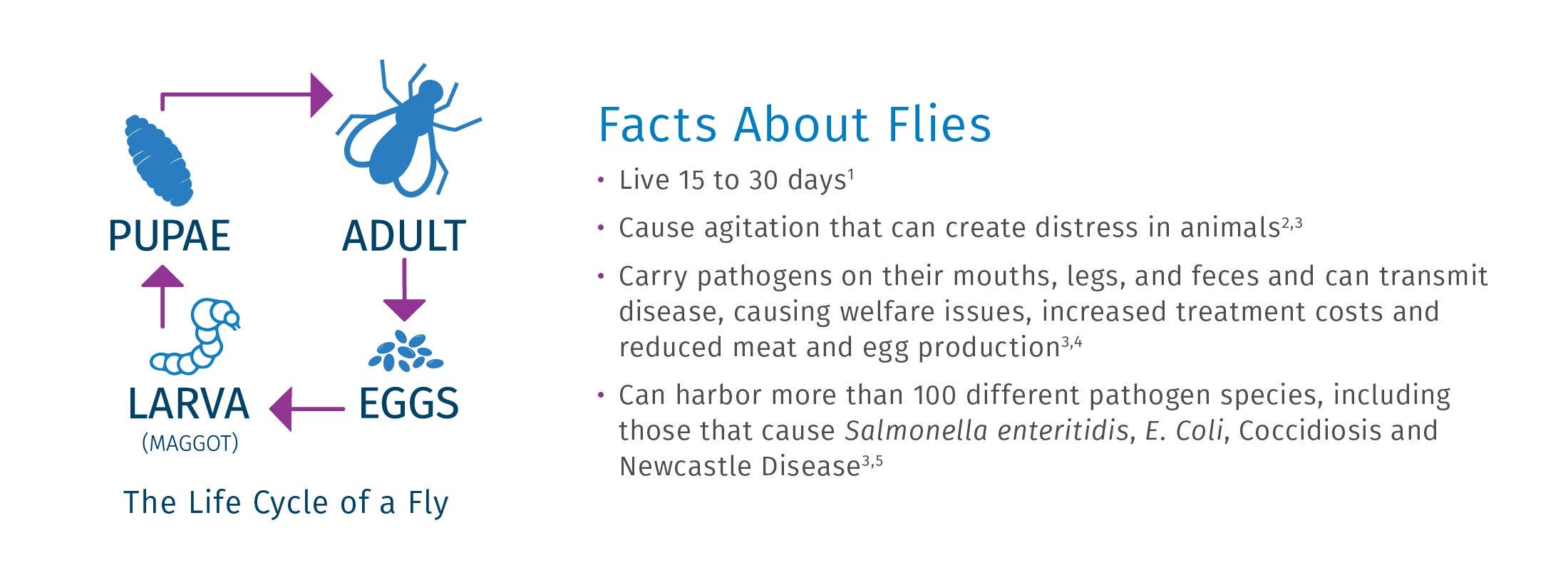Richard Hack
Richard graduated from Clemson University with a Master of Agriculture in development and marketing of parasiticides. His areas of expertise include the development of parasiticides for livestock and companion animals.
Excessive numbers of flies in layer, breeder and turkey grow-out facilities are unacceptable for several reasons. Not only are house flies a nuisance to workers, but they also act as vectors for disease transmission. When fly populations are not properly managed, they can become a public health nuisance around poultry operations and neighboring communities.
An interesting fact: Scientists have calculated that a pair of flies beginning reproduction in April have the potential, under optimal conditions, to be the progenitors of 191 quintillion flies by August¹ if not controlled. With this rate of reproduction, house flies can:
- Have a significant impact on the economic performance of farms.
- Increase workforce expenses or cause delays to other productivity-related activities due to the extra cleaning costs incurred between flocks to remove the excrement left by flies on equipment and farm facilities.
- Become a public health issue to neighbors.
Fly life cycle and behavior patterns
Flies are an issue in poultry facilities where manure breeding sites are abundant and manure management is poor. This is especially true in layer, breeder and turkey grow out – production systems. The ease with which flies can move between the inside and outside of the poultry houses and have access to breeding material helps facilitate their development and persistence on the farm.
House flies lay eggs, hatch, and become larvae before they pupate and finally hatch into adults to repeat the life cycle throughout the fly season.

When house flies are not laying eggs, they are typically found around windows, doors and the ceiling areas of buildings. These resting places are generally near favorite daytime feeding and breeding areas and sheltered from the wind. At night, flies are normally inactive. Both male and female flies feed and live in all kinds of undesirable areas including decomposing human and animal food, garbage and excrement.
The distribution of fly populations is greatly influenced by their reaction to light, temperature and humidity as well as surface color and texture. At very low temperatures, the species can stay alive in a dormant state in the adult or pupal stages.
While exact values vary slightly, adult fly activity may begin around an average temperature of 44°F (6.7°C). At this temperature range the flies are still relatively inactive and can only crawl slightly from 45-48°F (7.2-8.9°C) and can only fly at temperatures of 53°F (11.6°C) or warmer. Adult house flies appear to seek temperatures exceeding 60°F (15.6°C) when possible. However, lower temperatures are associated with longer duration of survival².
Most flies seem to stay within a half mile or mile from their breeding place. In general, the effective dispersal range of house flies appears to be less than 2 miles. Maximum distances of 10-20 miles have been recorded with only 8-30% of flies dispersing beyond their source poultry facility².
Economic impact of flies
Flies can have a significant impact on the economic performance of farms. Apart from the potential spread of disease, flies can dissolve bird feces and damage egg quality due to ‘fly spotting’ on the eggshells. Additionally, the logistics required for implementing a fly control program increases workforce expenses or causes delays to other productivity related activities. Extra cleaning costs are incurred between flocks to remove the excrement left by flies (regurgitation, feces) on equipment and farm facilities.
To help manage the negative economic implications of fly infestations, Elanco offers a portfolio of larvicides and adulticides to help poultry producers manage fly populations. Contact your Elanco sales team or distributor for more information.
Tags
Fly control for chickens
Insecticides
Layers
¹ Sanchez-Arroyo H., Capinera J.L. 2017. House fly, Musca domestica Linnaeus. Featured Creatures, University of Florida. Available online.
²Stafford, K.C. 2008. Fly Management Handbook. A Guide to Biology, Dispersal, and Management of the House Fly and Related Flies for Farmers, Municipalities, and Public Health Officials. The Connecticut Agricultural Experiment Station, New Haven, USA. Available online.
